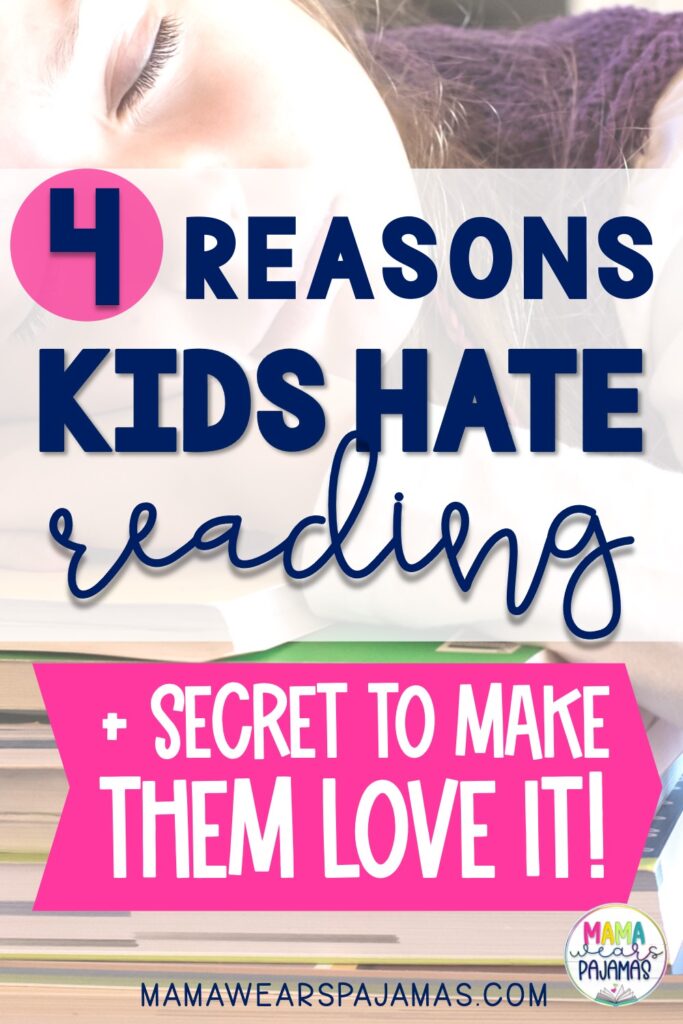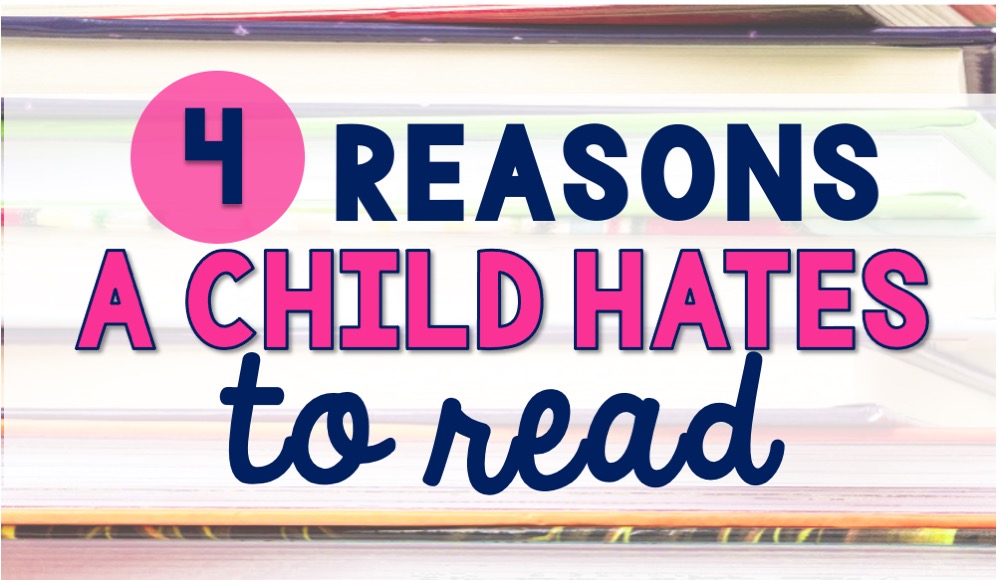Ever just want to scream “THIS CHILD HATES READING!!” or feel like it’s such a struggle to get your kid to want to pick up a book?
As a teacher, this was a common issue I would hear from parents every year.
I was constantly trying to figure out how to encourage reading in the classroom.
Below, I’m going to give you the four most common reasons a child hates reading and what you can do to solve it.
**This post may contain affiliate links to Amazon or other affiliate partnerships. I earn a small commission if you choose to purchase through a link. However, I do not recommend products unless I have personally used AND loved them.**
1. They Feel Forced to Read
True story- I HATED TO READ when I was growing up.
Reading always felt like a chore.
At school, there were always reading competitions, and the same students won every time– the students that read the longest, thickest chapter books.
I didn’t struggle to read, but I definitely wasn’t the quickest reader.
I was the one that would read the first paragraph, get distracted and have no clue what I read.
Solution
Try not to force your students or child to read. Instead, carve out daily time for the entire class or family to read.
Throughout this post, you will find many suggestions that will help make reading more fun.
2. There are Too Many Distractions
As a parent, our house is always busy.
As a teacher, our classroom is always busy.
The TV is always on at home and there is constant movement and talking in the classroom..
When I read with my toddler, we MUST go to a quiet space in an empty room.
I have to make sure nothing fun is happening in the living room, or he won’t focus on me.
That’s how most kids (and adults) are wired.
So for elementary students, they may not be able to focus on reading a book if there is something going on around them. They sure don’t want to miss out.
Solution for Parents at Home
My solution is to carve out a block of time for the ENTIRE family to read (maybe start with 30 minutes and then adjust from there).
This means NO distractions– TV’s off, tablets are off and on the table, everyone has used the restroom, had a snack, and has found their cozy place to read.
(Think about how CALMING this would be for your family- can you imagine the benefit of making this a nightly routine??)
You might use this time to read aloud to your child, especially in the beginning, to model what a good reader sounds like.
Break out your best character voices, and leave them with a cliffhanger to make them want to continue reading later.
Solution for Teachers in the Classroom
If you have students that hate reading, and are always looking around the room instead of their book, look at where they sit.
Is there a way you can switch up your seating chart and move those students to places that don’t allow for distractions?
You could also try giving them headphones and allowing them to listen to the first few chapters of the book through audio while following along with the text.

3. They Haven’t Found the Right Book
I know, I know. You’ve tried everything and they just aren’t interested.
You might THINK you know every single thing your child is interested in.
But, a child’s interest changes daily. Let me give you an example.
You may know a child is interested in animals. But, they may not be interested in a fictional novel about a dog.
Maybe they would prefer something non-fiction that teaches them about different types of dogs, or how to train a dog.
Non-fiction has become extremely popular for kids today. I think it’s because it has photographs to see, and you don’t have to read a non-fiction book in order. Kids love skipping around.
See some of my favorite non-fiction books for kids, linked here.
Solution for Choosing the Right Book
Have you shown your child (or students) the non-fiction section?
Oftentimes, we tend to lead children to books that we were interested in as kids. But, those books may be completely boring.
I wrote a post that includes 25 things kids can read other than fictional books. Check it out in this post.
4. They Struggle to Read
If a child is trying to read books that are far above their reading level, they won’t comprehend what they are reading.
Even if they can read every word, they may not understand what they are reading.
If a child is reading books that are on their reading level, and still struggling to read, they may have a weak phonetic foundation.
Your child’s teacher will be able to tell you what is typical for their age and if you need to have them evaluated for any reading disabilities.
Did you know that 1 in 5 children have some degree of dyslexia?
Solution for Struggling Readers
The first step is to have your child’s teacher assess their reading skills to see strengths and weaknesses.
Have your child listen to audiobooks! Bonus if they have the actual book to be able to follow along.
Audiobooks allow your child to hear the words to grow their vocabulary, while also allowing them to practice visualizing what the characters, setting and plot look like. This is a skill that all readers must learn.
Read to your child. No child is too old (or young) to be read to. Even advanced readers can benefit from hearing someone else read. I know teachers that still read to their high school children each night!
Read a book that is also a movie! Plan to have a movie night (complete with snacks, pjs, and maybe friends) when you finish the book.
You can see my favorite books that are movies linked here!
Other Resources You May Enjoy
Printable Reading Skills Anchor Charts – Includes printable posters for each Literacy standard
25 Things a Child will Enjoy Reading OTHER than your typical book.
Download my FREE rules and procedures CHECKLIST, here
Check out Edutopia’s article on encouraging kids to love reading.
PIN THE IMAGE BELOW FOR LATER!

The four reasons above are the most common reasons a child hates reading. Try out a few of my suggestions and let me know what you think!


